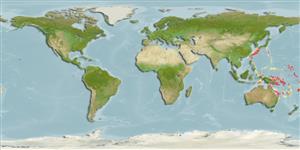Common names from other countries
Classification / Names / Names
Common names | Synonyms | Catalog of Fishes (gen., sp.) | ITIS | CoL | WoRMS
Environment: milieu / climate zone / depth range / distribution range
Ecology
Benthic; depth range 180 - 540 m (Ref. 3113), usually 300 - 400 m (Ref. 7976). Tropical
Western Central Pacific: Australia and Papua New Guinea.
Length at first maturity / Size / Weight / Age
Maturity: Lm ? range ? - ? cm Max length : 13.9 cm BL male/unsexed; (Ref. 7976)
Minimum depth from Ref. 7976. Inhabits continental shelf and slope (Ref. 7976).
Life cycle and mating behavior
Maturity | Reproduction | Spawning | Eggs | Fecundity | Larvae
Members of the order Isopoda are mostly gonochoric. Mating behavior: Mating usually occurs before and sometimes during the parturial molt. Sperm transfer is indirect. Life cycle: Eggs are brooded in the marsupium, which later hatch into manca postlarva before developing into adults.
Lowry, J.K. and K. Dempsey. 2006. (Ref. 7976)
IUCN Red List Status (Ref. 130435)
CITES status (Ref. 108899)
Not Evaluated
Not Evaluated
Human uses
| FishSource |
Tools
More information
Age/Size
Growth
Length-weight
Length-length
Morphology
Larvae
Abundance
Internet sources
Estimates based on models
Preferred temperature
(Ref.
115969): 11.7 - 17.4, mean 14.3 (based on 26 cells).
Vulnerability
Low vulnerability (10 of 100).
Price category
Unknown.
